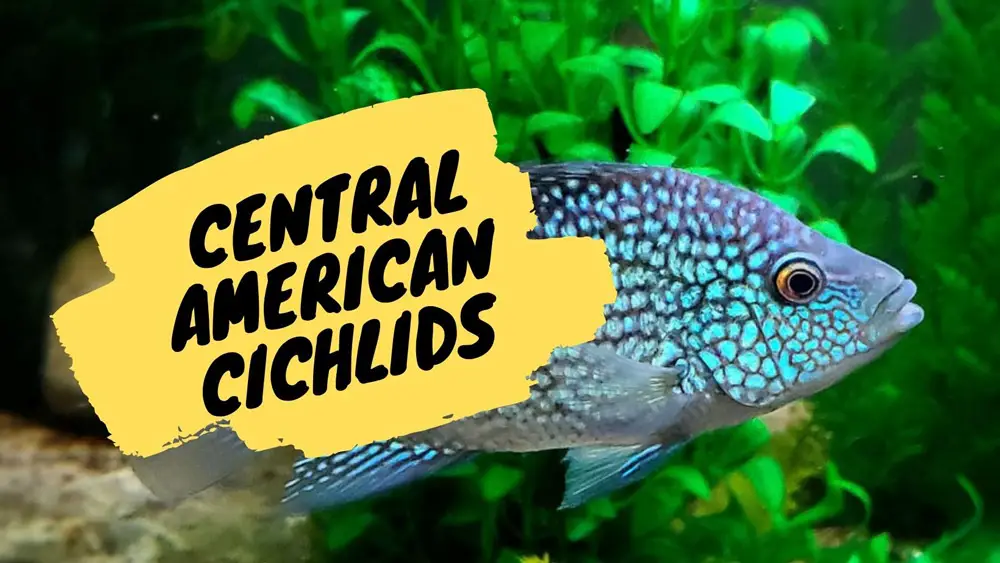Central America is a haven for fish lovers, and the region’s diverse Cichlid species provide enthusiasts with many options when it comes time to start their aquarium collections.
These colorful, intelligent cichlids come from various environments, including volcanic lakes and fast-flowing rivers/streams. Some have even adapted themselves toward brackish waters.
Central American cichlids are some of the most social fish around. They form mated pairs, spawn in caves or on rocks to protect their young ones from predators while both parents help take care of them.
When it comes to personality, the SA/CA Cichlids are my favorite. They’re much more intelligent and personable than Africans! The African Cichlids have some great colors, but they just seem like they’re going through a series of behavioral routines until they play a nip and chase game.
With these small but vibrant Central American cichlids that have more social dynamics to their interactions, you can actually see how much personality goes into every single behavior displayed on their little faces.
If you are on the hunt for your first CA cichlid, you have a lot of options. In fact, there are so many intriguing fish to choose from that some aquarists have trouble picking!
That’s where this list of Central American Cichlids will come in handy. Given the wide variety of CA Cichlid profiles available, I’m going to break this article up by genera and most popular species.
No further ado, let’s get started!
10 Most Popular Central American Cichlids For Your Tank
Amatitlania nigrofasciata (Convict cichlid)

Amatitlania nigrofasciata, also known as Convict Cichlid and Zebra Cichlid, is one of the most popular Central American cichlids due to their interesting coloring and low care requirements.
Convict cichlids are named for their dark vertical bands that run down their greyish-blue bodies. Various color patterns are available based on age, gender, and type. The female convict has bright gold markings on the belly and dorsal fins.
The Convict Cichlid is an aggressive and territorial fish that can only be kept with similarly sized or much larger fish with the same temperament. One convict cichlid alone or matched pairs in a species only tank are two common choices.
You might be interested to know: How Big Do Convict Cichlids Get?
| Scientific Name: | Amatitlania nigrofasciata |
| Common Name: | Convict Cichlid |
| Care Level: | Beginner |
| Lifespan: | 10 years |
| Size: | Male: 5 – 6″, Female: 3 – 4″ |
| Temperature: | 74.0 to 82.0° F |
| PH: | 6.0-8.0 |
| Water hardness: | 10 to 15 dH |
| Diet: | Omnivore |
| Minimum Tank Size: | 30 gallons |
| Temperament: | Aggressive |
Amatitlania Sajica (Sajica Cichlid)
Amatitlania sajica, the Sajica cichlids or T-bar cichlids, are more colorful than their popular cousin, the Amatitlania nigrofasciata (Convict cichlid). They are peaceful compared to other Central American cichlid species.
The fish’s body is a beautiful tan with seven faint bars. The third bar shows prominently and gets paired up with a dark horizontal stripe that runs from gills forms a “T” bar, making it unique among other species. The mature male Sajica has elongated fins which equal his tail in length, while females have a beautiful yellow hue on their dorsal fins.
Sajica cichlids are mildly aggressive can be kept in community tanks with 1 male and several females, but do not keep more than one male in the tank to prevent fighting. The males can be really aggressive with a female that is not ready to spawn, even going so far as to kill her.
| Scientific Name: | Amatitlania Sajica |
| Common Name: | T-bar cichlid, Sajica cichlid |
| Care Level: | Beginner |
| Lifespan: | 2-5 years |
| Size: | 5″ |
| Temperature: | 76 – 80°F |
| PH: | 7.0 -7.6 |
| Water hardness: | 7 to 15 dH |
| Diet: | Omnivore |
| Minimum Tank Size: | 30 gallons for a single fish, 60 gallon for a pair |
| Temperament: | Mildly Aggressive |
Amatitlania Septemfasciata (Seven Stripe Cichlid)
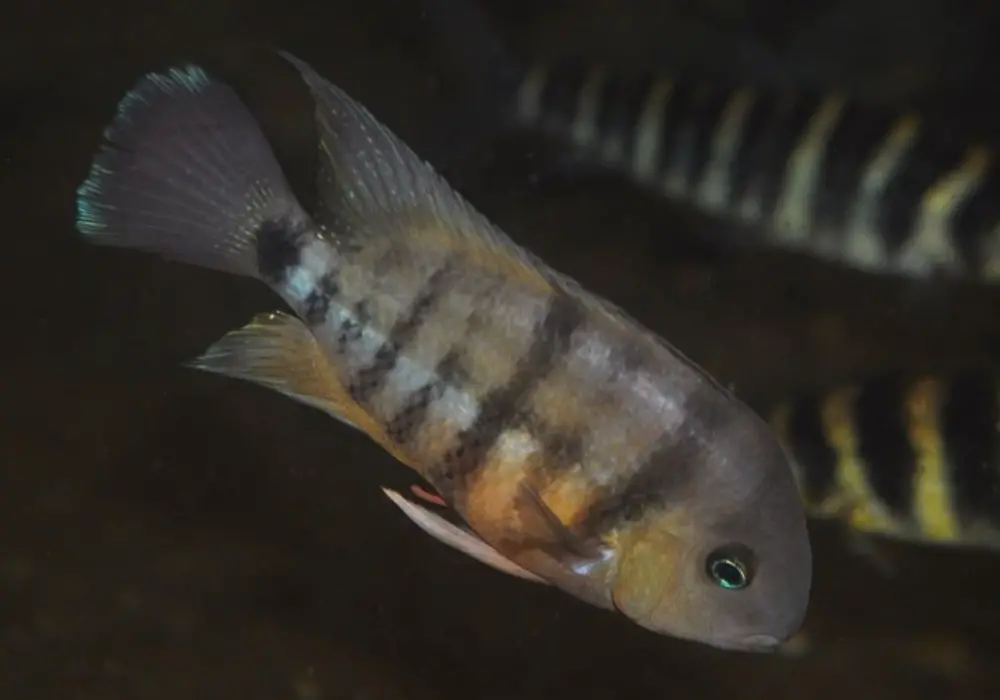
The Amatitlania septemfasciata is another relatively peaceful, smaller growing Amatitlania member available. The fish are most often found in the San Juan River and the Banano River in Central America.
In general, males grow larger than females. The males can grow up to 5 inches long, but females only reach 4″. Their blue-grey body is covered in six vertical bars on each side, but females have a noticeable black spot on the dorsal fin that’s complemented by streaks of metallic coloration.
Like Sajica cichlids, they will not be as aggressive as other large Central American cichlids. It is best to keep this species in a tank with compatible pair. Stocking them with robust, hardy, and similarly-sized cichlids in a fairly large community tank that provides plenty of hiding places is practicable.
| Scientific Name: | Amatitlania Septemfasciata |
| Common Name: | Seven Stripe Cichlid |
| Care Level: | Beginner |
| Lifespan: | 2-5 years |
| Size: | 5″ |
| Temperature: | 75-80°F |
| PH: | 7.0-7.8 |
| Water hardness: | Hard |
| Diet: | Omnivore |
| Minimum Tank Size: | 60 Gallons |
| Temperament: | Mildly Aggressive |
Amphilophus Labiatus (Red Devil Cichlid)
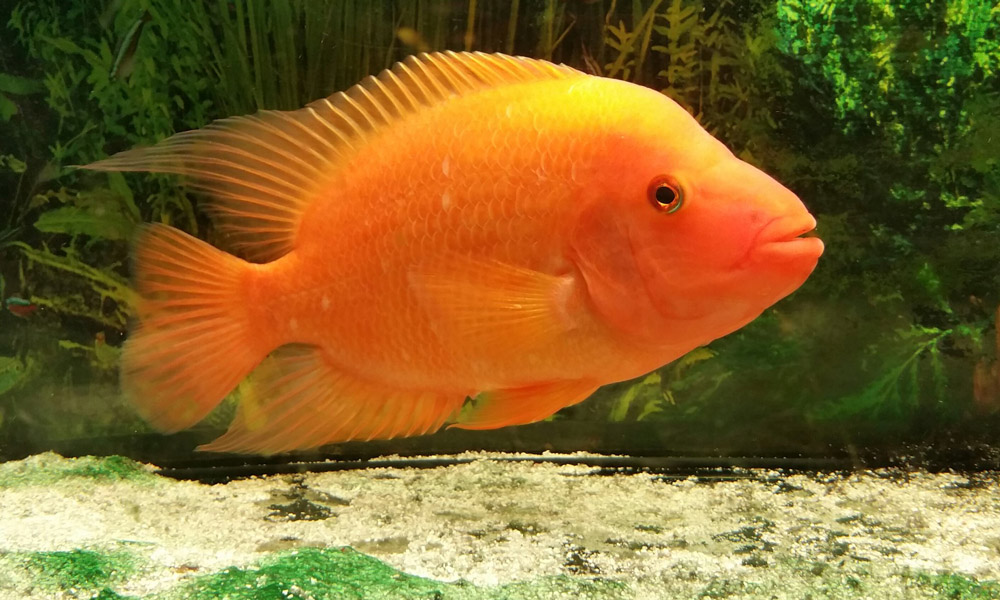
When it comes to the coolest fish in town, nobody beats Red Devil Cichlids. Its striking appearance and charismatic personality make it one of the most interesting CA Cichlids among aquarium enthusiasts everywhere.
Red Devil Cichlids are quite robust with pointed dorsal and anal fins. They also have large and thick lips that tend to be a bit smaller in the home aquarium, which can be either black or orange.
Their large, sharp teeth and strong jaws are capable of doing a lot of damage. Not only do these fish have the power to attack prey in aquariums, but they can also tackle their natural predators with ease out in the wild.
Owners of the Red Devil Cichlid will tell you that these fish are more than just aquarium companions. They have been known to form relationships with their owners. They can be very devoted and dramatic when it comes time to show off in front of an aquarist or even beg food like a dog!
| Scientific Name: | Amphilophus Labiatus |
| Common Name: | Red devil cichlid |
| Care Level: | Intermediate |
| Lifespan: | 12 years |
| Size: | 15″ |
| Temperature: | 75-79°F |
| PH: | 6.5-7.5 |
| Water hardness: | 6 – 25 dGH |
| Diet: | Omnivore |
| Minimum Tank Size: | 55 gallons for a single fish |
| Temperament: | Large Aggressive (Predatory) |
Amphilophus Citrinellus (Midas cichlid)

The Midas Cichlids, Amphilophus citrinellus, are natively found in the San Juan River and the adjacent watersheds of Costa Rica and Nicaragua. Today you can find them in the state of Florida. With its showstopping coloration and variety, this species will surely make a striking addition to your collection.
The fish’s body is generally dark brown with six stripes and a large spot on one side in the wild. There’s also naturally occurring in this variety which has a yellow coat.
Captive bred coloration ranges from black to orange, white, and red. It’s no wonder that the name of this fish is called “Midas”, the most common color is usually a creamy yellow, golden, or orange with blotches.
Due to its large size and natural aggression, the Midas Cichlid demands a large aquarium of at least 200 gallons. They can be kept alone or in a pair. The Midas will become very aggressive in a small tank and may wipe out your entire setup.
The Midas Cichlid has an almost identical appearance to the red devil cichlid, but it’s a totally different species.
| Scientific Name: | Amphilophus Citrinellus |
| Common Name: | Midas cichlid |
| Care Level: | Intermediate |
| Lifespan: | 12 years |
| Size: | 14″ |
| Temperature: | 72-82°F |
| PH: | 6.6-7.3 |
| Water hardness: | 10 – 20 dGH |
| Diet: | Omnivore |
| Minimum Tank Size: | 55 gallons for a single and 125 Gallons for a pair |
| Temperament: | Large Aggressive (Predatory) |
Herichthys Cyanoguttatus (Texas Cichlid)
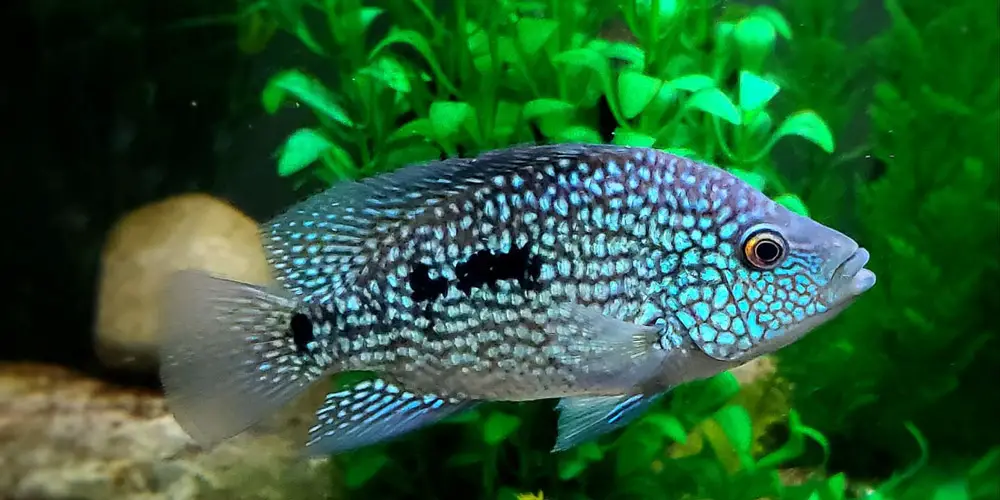
The Herichthys cyanoguttatus (Texas cichlid) is the only cichlid species that originates from the United States. This large, bold, iridescent fish is an excellent choice for any aquarist who wants to take their tank game up a notch.
The territorial Texas cichlids can reach up to 13″ in length when fully grown. A large freshwater tank is required. It’s best to keep them on their own in a 75 gallon aquarium, but it can be housed with other large Central American cichlids in a tank of at least 125 gallons. Breeding pairs need at least 125 gallons, but be prepared to divide the tank into two separate parts in case of incompatible.
This fish is known for its stunning look. A juvenile Texas cichlid has pearly gray with white dots on its fins. As it ages, two black dots will appear in the middle of the body and the caudal fin. A mature fish displays a golden shade with pearly iridescent speckles.
Like its Central American relatives, the Texas Cichlid is fairly undemanding and adapts well to range water conditions in the aquarium. However, some specimens are exceedingly aggressive, not recommended for beginners.
| Scientific Name: | Herichthys Cyanoguttatus |
| Common Name: | Texas Cichlid |
| Care Level: | Intermediate |
| Lifespan: | 15 years |
| Size: | 12″ |
| Temperature: | 70-75°F |
| PH: | 6.5-8.0 |
| Water hardness: | 8 – 15 dGH |
| Diet: | Omnivore |
| Minimum Tank Size: | 50 gallons for a single fish and 100 gallons for a pair |
| Temperament: | Aggressive |
Herotilapia Multispinosa (Rainbow Cichlid)

The rainbow cichlid is a very popular species in the freshwater aquarium trade. They’re not just beautiful; they have an interesting behavior that makes them worth getting.
While these fish can reach 6 1/2 inches (17 cm) in the wild, they are significantly smaller when grown at the home aquarium and only grow to be about 3 inches long, considered to be the smallest of the CA Cichlids.
They are fairly peaceful, especially by Central American standards, an excellent choice for beginners who want to try their hands at caring Cichlids. You can keep the rainbow cichlid alone or in pairs as well as in a community tank.
Their brilliant “rainbow” color is certainly worthy of their name. Rainbow cichlids normally display colors from gold to orange with black bars on their bodies that run the length of it, making them look quite impressive!
| Scientific Name: | Herotilapia multispinosa |
| Common Name: | Rainbow Cichlid |
| Care Level: | Beginner |
| Lifespan: | 7 – 9 years |
| Size: | 3″ |
| Temperature: | 72-77°F |
| PH: | 6.5-8.0 |
| Water hardness: | 5 – 20 dGH |
| Diet: | Omnivore |
| Minimum Tank Size: | 20 gallons |
| Temperament: | Peaceful |
Rocio octofasciata (Jack Dempsey Cichlid)
The Jack Dempsey Cichlid (Rocio octofasciata) is one of the most well-known Central American Cichlids. With its aggressive behaviors and stocky body, the common name for this fish comes from its similarity to the famous 1920s boxer Jack Dempsey.
These fish have long fins and large oval bodies decorated with dark purple-grey with iridescent gold flecks. The colors change with age, and Juvenile Jack Dempseys are naturally less colorful than adults. Adults are truly stunning with bright blue-green flecks.
The Jack Dempsey is a fun fish to have around, and it’s easy for beginners because they don’t need much care. These bruisers prefer to stay on their own and are not good community fish. Don’t keep them in pairs because they become more territorial and aggressive.
| Scientific Name: | Rocio octofasciata |
| Common Name: | Electric Blue Dempsey, Blue Dempsey, Neon Blue Dempsey |
| Care Level: | Beginner |
| Lifespan: | 15 years |
| Size: | 8″ |
| Temperature: | 72-86°F |
| PH: | 6.5-7.0 |
| Water hardness: | 8 – 12 dGH |
| Diet: | Omnivore |
| Minimum Tank Size: | 40 gallons |
| Temperament: | Semi-aggressive |
Thorichthys meeki (Firemouth Cichlid)

The firemouth cichlid is a beautiful and vibrant freshwater fish with a lot to offer. They’re so entertaining; you’ll find yourself on the edge of your seat for hours as they swim around.
The appearance of the firemouth cichlid is really what makes them stand out. The fish gets its name because of the fiery coloration on the underside of the body. Males are typically brighter than females, while females have a larger and rounder belly. Both males and females have a black mark located on the lower half of the operculum.
The recommended tank size depends on how many you’re keeping, but a minimum of 30 gallons should suffice for just one fish. Firemouth cichlids are peaceful, so they’re a good choice for large community tanks. You can also keep them with other Central American Cichlids.
You might be interested to know: Firemouth Cichlid Size: How Big Do Firemouth Cichlids Get?
| Scientific Name: | Thorichthys Meeki |
| Common Name: | Firemouth Cichlid |
| Care Level: | Beginner |
| Lifespan: | 15 years |
| Size: | 6.7″ |
| Temperature: | 75-79°F |
| PH: | 6.5-8.0 |
| Water hardness: | 8 – 15 dGH |
| Diet: | Omnivore |
| Minimum Tank Size: | 30 gallons |
| Temperament: | Semi-aggressive |
Vieja melanurus (Redhead Cichlid)
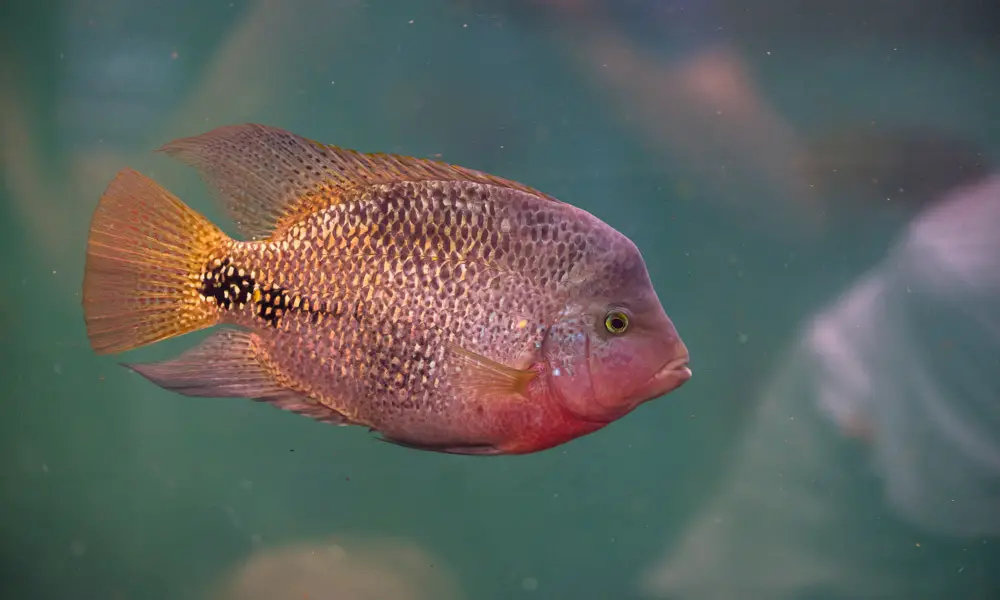
While they may not be as popular as Rainbow Cichlids or Jack Dempseys in the hobby, the Redhead Cichlids are an excellent choice for those looking to keep Central and South American cichlids.
Viejas melanurus, also known as the Redhead Cichlid and Quetzal fish, is a stunning Mexican species that matures to pastel colors. The Redhead Cichlid is so named due to its head’s pinkish-red coloration.
The most eye-catching feature is the nuchal hump that grows on the head of males. Adults develop brilliant colors such as a red forehead, vivid greenish, red, orange, and blue tones on the body.
Redhead Cichlids are perhaps the most gentle species in this genus. They’re territorial when it comes time for them to spawn, but not excessively violent or aggressive like some other types of fish can be during these moments.
Breeding the Redheaded Cichlid can be difficult because of its low compatibility among pairs. It’s best to keep a group of six juveniles to pair off for successful breeding.
| Scientific Name: | Vieja melanurus |
| Common Name: | Redhead Cichlid |
| Care Level: | Beginner |
| Lifespan: | 10 years |
| Size: | 14″ |
| Temperature: | 76-86°F |
| PH: | 7.5 – 8 |
| Water hardness: | 10 – 15 dGH |
| Diet: | Omnivore |
| Minimum Tank Size: | 75 gallons |
| Temperament: | Semi-aggressive |
Full List of Central American Cichlids
| Genus | Recognized Species |
|---|---|
| Amatitlania | Amatitlania altoflava Amatitlania coatepeque Amatitlania kanna Amatitlania myrnae Amatitlania nanolutea Amatitlania nigrofasciata (Convict cichlid) Amatitlania septemfasciata (Seven Stripe Cichlid) Amatitlania sajica (T-bar cichlid, Sajica cichlid) Amatitlania siquia |
| Amphilophus | Amphilophus amarillo Amphilophus astorquii (Black Midas Cichlid) Amphilophus chancho (Chancho Cichlid) Amphilophus citrinellus (Midas cichlid) Amphilophus flaveolus Amphilophus globosus Amphilophus hogaboomorum Amphilophus labiatus (Red devil cichlid) Amphilophus lyonsi (Lyonsi Cichlid) Amphilophus margaritifer Amphilophus sagittae Amphilophus supercilius Amphilophus tolteca Amphilophus viridis Amphilophus xiloaensis Amphilophus zaliosus (Arrow Cichlid) |
| Cryptoheros | Cryptoheros chetumalensis Cryptoheros cutteri (Cutter’s cichlid) Cryptoheros panamensis Cryptoheros spilurus (Blue Eye Cichlid) |
| Cichlasoma | Cichlasoma bocourti Cichlasoma istlanum (Redside cichlid) Cichlasoma pearsei (Pantano cichlid) Cichlasoma urophthalmus (Mayan cichlid) |
| Herichthys | Herichthys bartoni (Barton’s Cichlid) Herichthys carpintis (Pearlscale Cichlid) Herichthys cyanoguttatus (Texas Cichlid) Herichthys deppii (Nautla Cichlid) Herichthys labridens Herichthys minkleyi Herichthys pantostictus Herichthys steindachneri Herichthys tamasopoensis |
| Hypsophrys | Hypsophrys nematopus Hypsophrys nicaraguensis |
| Nandopsis | Nandopsis beani Nandopsis grammodes (Mini Dovii Cichlid) Nandopsis haitiensis (Haitian Cichlid) Nandopsis ramsdeni Nandopsis salvini Nandopsis tetracanthus (Cuban Cichlid) |
| Neetroplus | Neetroplus nematopus |
| Parachromis | Parachromis dovii (Wolf cichlid) Parachromis friedrichsthalii (Yellow Jacket Cichlid) Parachromis managuensis (Jaguar cichlid) Parachromis motaguensis (False Yellowjacket Cichlid) |
| Paraneetroplus | Paraneetroplus bulleri (Sarabia cichlid) Paraneetroplus gibbiceps (Teapa cichlid) |
| Rocio | Rocio ocotal Rocio octofasciata (Jack Dempsey Cichlid) Rocio octofasciatum Rocio spinosissimus Rocio spinosissima |
| Rheoheros | Rheoheros lentiginosus (Freckled cichlid) Rheoheros coeruleus |
| Theraps | Theraps godmanni (Southern checkmark cichlid) Theraps intermedius (Northern checkmark cichlid) Theraps irregularis (Arroyo cichlid) Theraps wesseli (Wessel’s Cichlid) Theraps microphthalmus |
| Thorichthys | Thorichthys affinis Thorichthys aureus Thorichthys callolepis Thorichthys helleri (Yellow cichlid) Thorichthys maculipinnis (Spot Cheek Cichlid) Thorichthys meeki (Firemouth cichlid) Thorichthys panchovillai Thorichthys pasionis Thorichthys socolofi (Chiapas cichlid) Thorichthys meeki (Firemouth cichlid) |
| Tomocichla | Tomocichla asfraci Tomocichla tub |
| Vieja | Vieja bifasciata (Twoband cichlid) Vieja breidohri (Angostura cichlid) Vieja guttulata (Amatitlan cichlid) Vieja maculicauda (Blackbelt Cichlid) Vieja melanurus (Redhead cichlid, Synspilum Cichlid) Vieja zonata (Oaxaca cichlid) Vieja guttulata (Amatitlan cichlid) Vieja Hartwegi (Tailbar cichlid) |
Final Words
As you can see, the Central American Cichlids are a lively bunch! They come in all shapes and sizes and have a lot of personalities.
The small, peaceful, and colorful rainbow cichlid and unique Convict Cichlid can be an interesting choice for beginners. For the experienced cichlid owners, the large and beautiful Jaguar Cichlid and Texas Cichlid will prove to be a fantastic addition.
We hope this list helps you find the right Central American Cichlids for your home tank. If there’s anything we can do to answer your questions, please feel free to contact us! We’re always eager to help readers who need advice on what fish would best suit their setup.
Happy fishkeeping!
